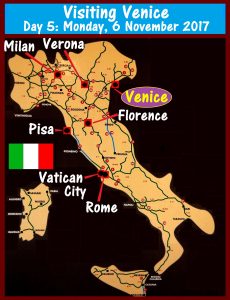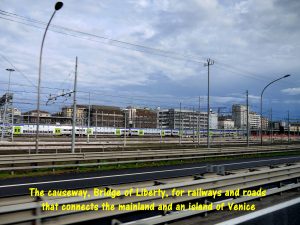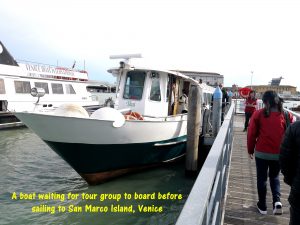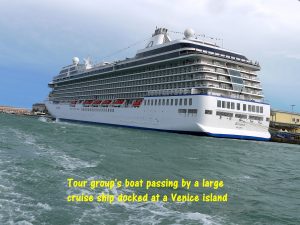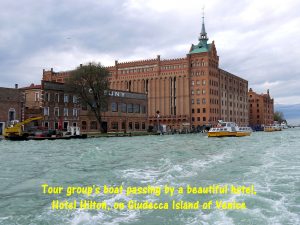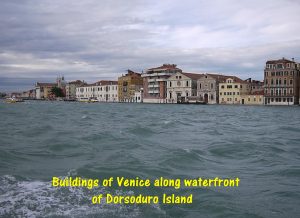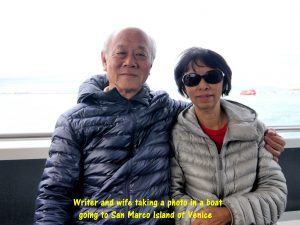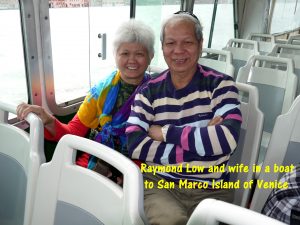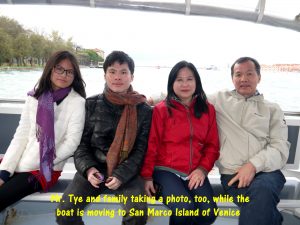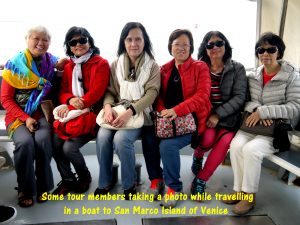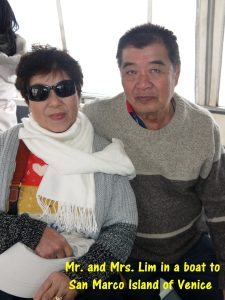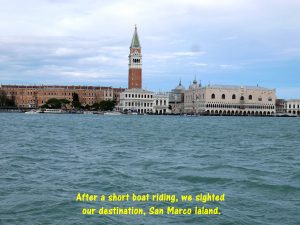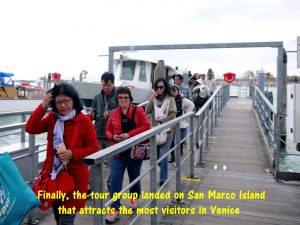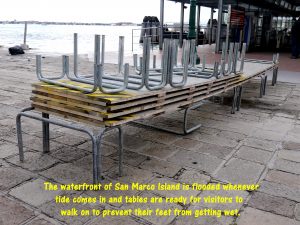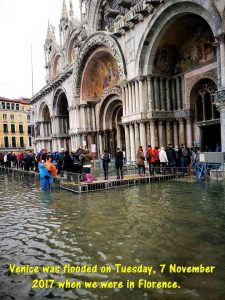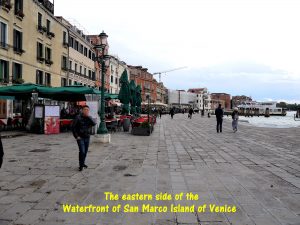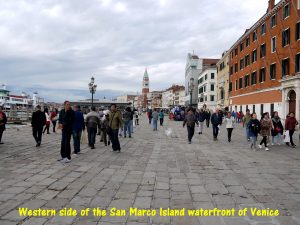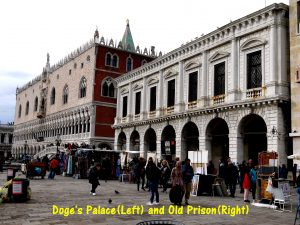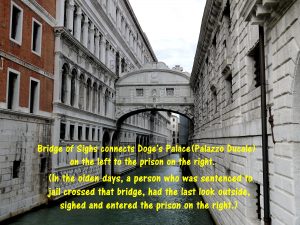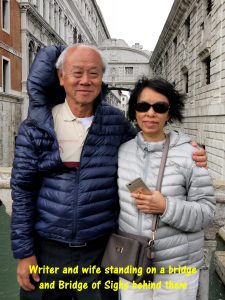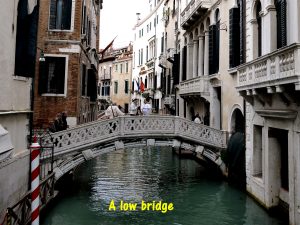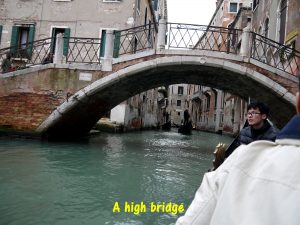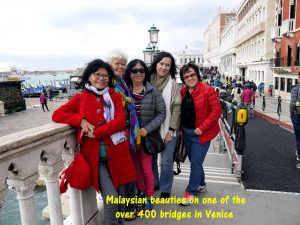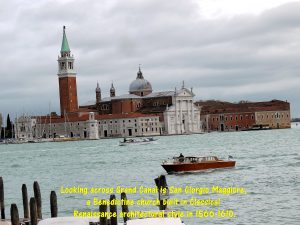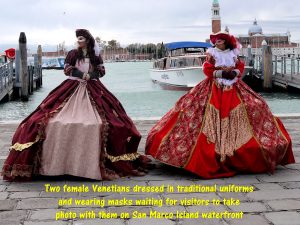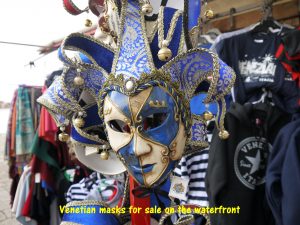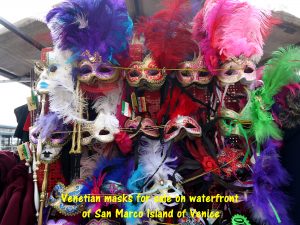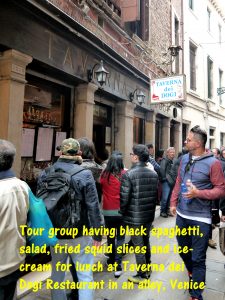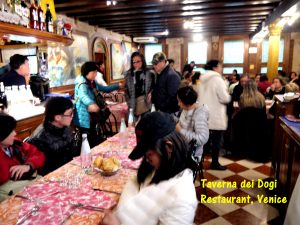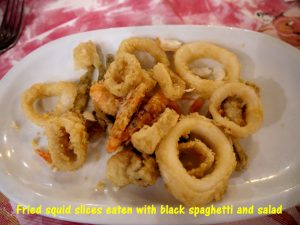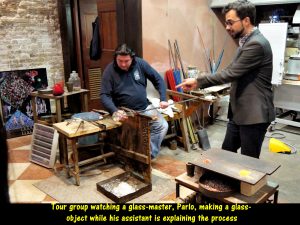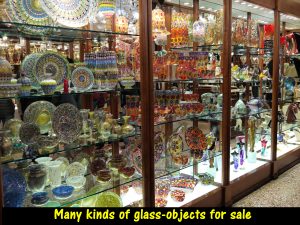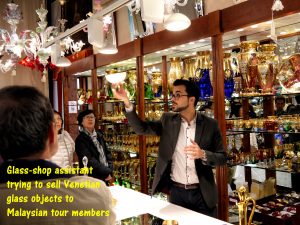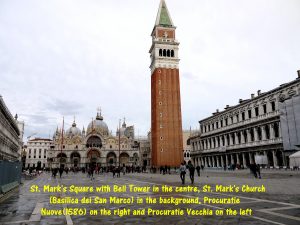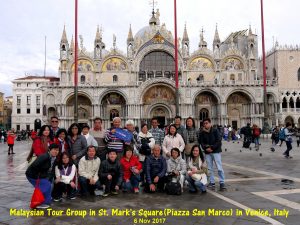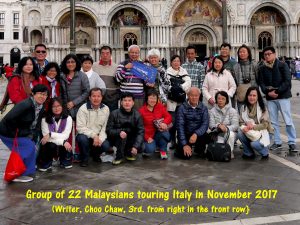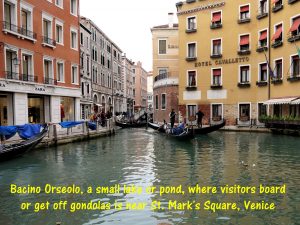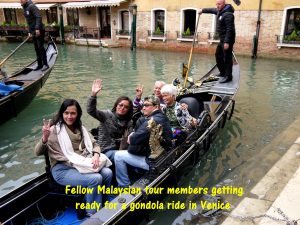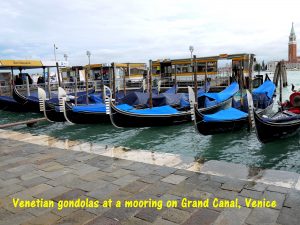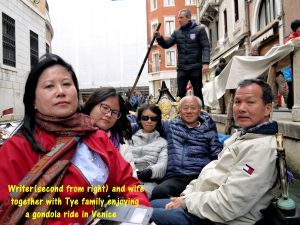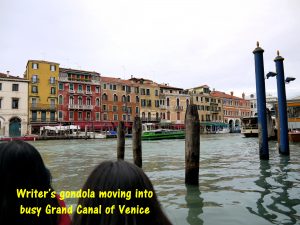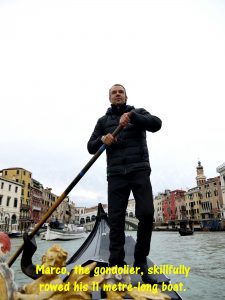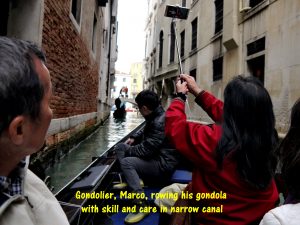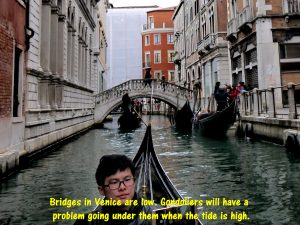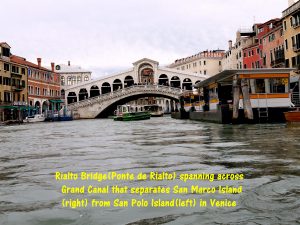Italy Travel Part IV: Venice
Italy Travel Part IV: Venice
Day 5: Monday, 6 November 2017
Journey from Florence to Venice
We left the Florence hotel, Hotel President, in the morning and travelled to Venice in the northeast of Italy.
Map of Italy showing the location of Venice
Venice
Venice is built on more than 100 islands in a lagoon. The islands are separated by canals, straddled by over 400 bridges. A causeway, Bridge of Liberty(Ponte della Liberta), connects the mainland to a small island of Venice.
Causeway
In the afternoon we arrived at the island of Venice after crossing the causeway from the mainland. Then we boarded a boat that took us to another but larger island, San Marco Island(St. Mark Island).
Spectacular Views
While sailing to San Marco Island we saw a few large cruise ships and spectacular views of old medieval buildings, hotels and churches on some islands.
Photographing
While sailing to the island, we took the opportunity to take some photos of ourselves in the boat for remembrance. Below are a few of them.
San Marco Island of Venice
After a 20 minute boat-ride, we sighted San Marco Island with a prominent bell tower known as St. Mark’s Bell Tower. The view was stunning.
Soon we arrived and disembarked at the jetty of San Marco Island.
Waterfront of San Marco Island
The waterfront is wide and about 1 metre above sea-level. Hence, it is prone to flooding whenever the tide is high. But tables kept on the waterfront are ready to be used by visitors if it is flooded.
Tables were used earlier by visitors queuing up to enter St. Mark Cathedral in San Marco Square.
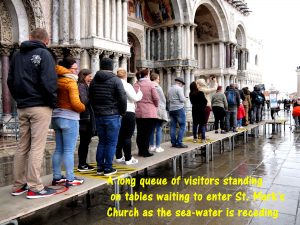
Visitors standing on tables to prevent their feet from getting wet in flooded San Marco Square, Venice
Flood in Venice
A flood occurred in Venice on the following day after our visit.
Venetian Buildings
On the waterfront there are several rows of old Venetian buildings. Among them are Doge’s Palace(Palazzo Ducale) and a prison separated by a narrow canal.
Doges of Venice
Doges of Venice were chief magistrates and leaders with supreme authority of the former Republic of Venice. They were elected for life. Venice was under their rule from 697 until 1797 when France under Napoleon Bonaparte(1769-1821) captured it.
Doge’s Palace(Palazzo Ducale)
Doge’s Palace built in Gothic architectural style and established in 1340 was the residence of the Doge of Venice until 1797 when France took over Venice. Later, the palace was taken over by Austria when Venice was ruled by Austria. In 1866 Venice became part of Italy.
Since 1923 it has become an art museum.
Bridge of Sighs
A bridge was built from Doge’s Palace to the prison next to it in 1614. Known as the Bridge of Sighs, it was built for criminals who were sentenced to jail. They had to walk across the bridge from Doge’s Palace where the court was situated to the prison.
While crossing the bridge, the criminals had a last look outside through the two windows, sighed and entered the prison to serve their sentences.
Over 400 Bridges in Venice
There are over 400 bridges in Venice. Most of them are short, straddling narrow canals and different from each other in design.
San Giorgio Maggiore Church
Standing on the waterfront I looked across a waterway, the Grand Canal, and saw a large church on Dorsoduro Island. It is called San Giorgio Maggiore, a 16 th. Century Benedictine church built in Classical Renaissance architectural style in the 1566-1610 period.
Venetian Ladies
On the waterfront we saw two ladies walking on stilts. They were dressed in traditional Venetian costumes and wearing masks. They were inviting visitors to take photos with them.
Venetian Masks
There were some souvenir stalls on the waterfront. The most common things they were selling were the Venetian masks.
Venetian masks are usually worn during the Carnival of Venice which is an annual festival in Venice. They may wear full-face masks or eye masks to hide their identity and social status.
Black Spaghetti for Lunch
When it was lunchtime, we went to a restaurant, Taverna dei Dogi, in an alley near St. Mark’s Square. We had black spaghetti or squid ink spaghetti, simple salad, fried squid rings and ice-cream for lunch.
Glass-Blowing Demonstration
After lunch, we walked to a glass-shop in Castello District which was nearby. At the shop we watched a glass-blower, Parlo, making a glass-object by traditional method. After the glass-blowing demonstration, we went to the glass showroom where many kinds of glass-objects were for sale, such as chandeliers, drinking glasses, glass figures, etc. But none of us bought any of them as it was troublesome to bring them home, 10 000 km away from Venice.
St. Mark Square(Piazza San Marco)
Later, we went to the most important place in Venice. It is the centre for social, political and religious activities of the city. It is known as St. Mark’s Square(Piazza dei San Marco).
St. Mark’s Bell Tower
In the centre of the square stands a tall tower, St. Mark’s Bell Tower. It is 98.6 metres tall and built in 1912 replacing the old one that collapsed in 1902. The first one was built in the 12th. Century as a watch-tower or lighthouse.
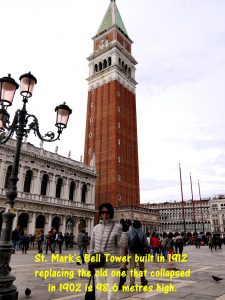
St. Mark’s Bell Tower built in 1912 to replace the old one that collapsed in 1902 is 98.6 metres high.
St. Mark’s Cathedral(Basilica dei San Marco)
On its western side is a large church, Basilica dei San Marco(St. Mark Cathedral). It was built in 978-1092 with five domes and five arches in front. It has a mixture of Italian, Byzantine and Gothic architectural styles.
It was built as a private chapel for the Doges until 1807 when the local bishop, Patriarch of Venice, took over in 1807.
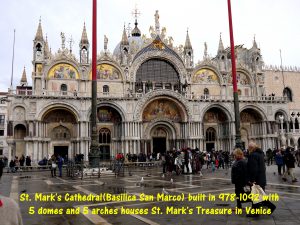
St. Mark’s Cathedral(Basilica San Marco) built in 978-1092 houses St. Mark’s Treasure in St. Mark’s Square,
The Church houses St. Mark’s Treasure consisting of 293 items in gold, silver, glass and other precious materials from various sources like from Constatinople, Western art, of Islamic origin and others.
Gondola Ride
Finally, we went to a pond or small lake, Bacino Orseolo, near St. Mark’s Square to ride gondolas.
A gondola is Venetian iconic boat that looks like a canoe. Painted black, it is 11 metres long with comfortable seats and ornately decorated.
10 000 Gondolas
About 200 years ago, there were approximately 10 000 gondolas, but now there are about 500 left. Those boats were the chief means of transportation in Venice in the olden days. Today most of them are used for carrying tourists who want to enjoy the ride.
Bacino Orseolo
A tourist gondola can carry 6 persons and is rowed by a gondolier. My wife and I together with 4 members of the Tye family sat in a gondola at Bacino Orseolo, a small lake. Our seating in the gondola was decided by the gondolier as he did not want his boat to be tilted to one side
Slow Gondola Ride
Shortly afterwards, we were moving away from the lake. The boat was moving slowly along narrow canals and part of the large canal known as Grand Canal, passing under low bridges.
Marco, the Gondolier
Our gondolier was Marco. We asked him to sing for us while he was rowing, but there was no response from him. Anyway, we enjoyed the sights and sounds of Venice as we were moving along the canals and under low bridges. The ride which lasted for about 20 minutes is a memorable one.
Rialto Bridge(Ponte de Rialto)
While riding in a gondola on Grand Canal, we saw an iconic bridge of Venice known as Rialto Bridge. Constructed in 1591, it spans Grand Canal and connects San Marco Island and San Palo Island.
Departure for Venice Mainland
Soon we left Venice’s San Marco Island and returned to the mainland of Venice. Then we headed west to a hotel, Hotel Da Porto, along Viale del Sole to stay overnight before going to Verona and Milan in the north the following day.
Italy Travel Part I: Rome and Vatican City
Italy Travel Part II : Rome(continued)
Italy Travel Part III: Pisa and Florence
Italy Travel Part IV: Venice
Italy Travel Part V(Final): Verona and Milan
Comments
Tell me what you're thinking...
and oh, if you want a pic to show with your comment, go get a gravatar!

